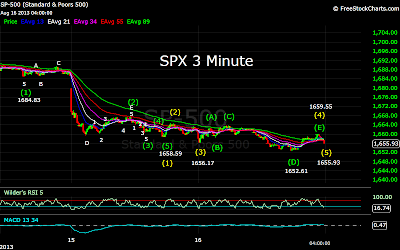The SPX opened with a gap to the downside,
dropping initially to 1640.36, which was followed by a small bounce, and then
1638.24. After another bounce that lifted the index to 1643.99, the SPX spent
the remainder of the trading session drifting ever lower, finding the low of
the day at 1629.05 shortly before the close.
Today’s action in the SPX would appear to be a
continuation of a single wave from yesterday’s 1669.51 high. From that high,
the index completed the first wave lower at 1666.76. After then completing
waves A, B, and C of an inverted corrective wave, the index began to form wave
D, which began to sub-divide. The first 4 waves completed near the close
yesterday afternoon, and completed this morning when the SPX reached 1638.24.
The bounce off of that low to 1643.99 then completed wave E, and the inverted corrective
wave 2 from 1666.76. As the market drifted lower this afternoon, it appears to
have completed waves 3, 4, and 5 from that high at 1634.27-1638.42-1630.41.
Looking at this entire move from the al-time high
of 1709.36, I count an initial wave down at 1684.91. From there the SPX
completed a complex inverted corrective wave that went 1700.18-1646.00-1661.83-1654.81-1669.51.
The wave that completed today at 1630.41 thus completed the third wave down from
the all-time high. Given that scenario, I would expect the market to move
higher at this point, before completing one more move down.
Since this move began, I have pointed to four
levels of support/resistance. Those levels have been 1685, 1669, 1651, and 1621.
The initial move lower reached the 1685 support level, with the next move lower
pausing at the 1651 level before breaking below it. The recent high took the
SPX to the 1669 resistance level. A move back to 1651 at this point would
target 1621 as the low of the 5th wave from 1709.
If this scenario plays out, the market will be at
a very decisive point. As I articulated before, a move to 1621-1685-1540 would
complete a semi-inverted corrective wave from 1687. I am still not convinced
that this move will carry below 1560, so if the SPX gets back to 1685, there is
a good chance that it will continue higher. There are still several ways in
which this market can go, so at this point it is best to keep a close watch on
the critical levels. If the SPX fails to reach 1651, it could be headed much
lower. A decisive break of the 1621 level would also point to lower levels. If
the SPX can find support at 1621, and then rally above 1669, it could be an
indication that this corrective wave may be over.








